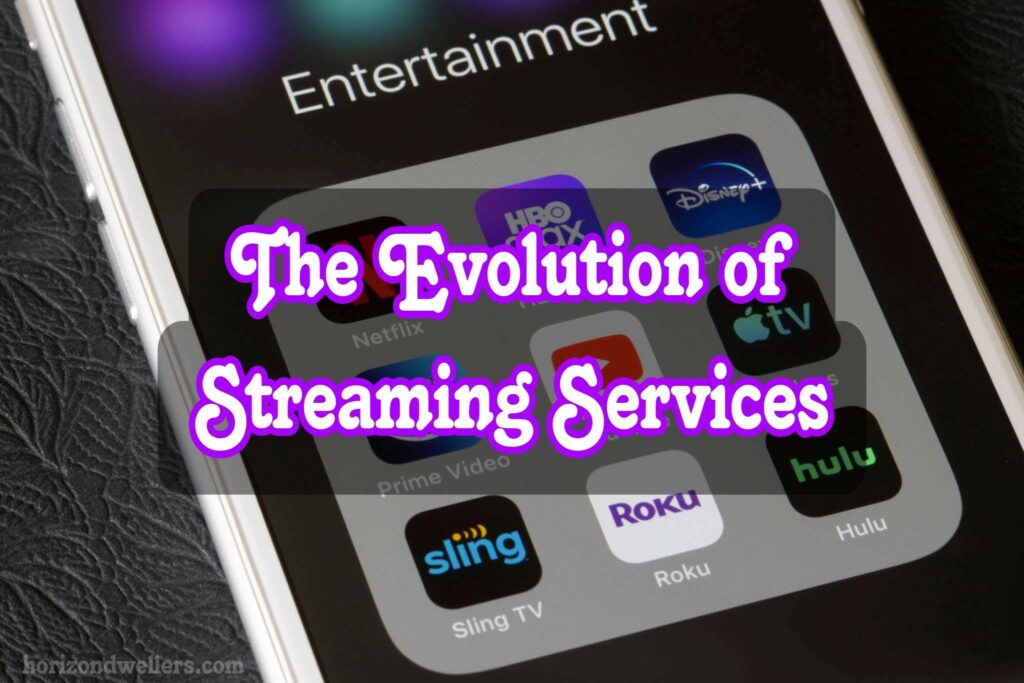The entertainment industry has seen a dramatic shift over the past decade with the rise of streaming services. These platforms have revolutionized the way we consume content, offering a vast array of movies, TV shows, and original programming at the touch of a button. As the landscape continues to evolve, it’s clear that streaming services have had a significant impact on the industry, shaping the way we engage with media and transforming the way content is delivered to consumers.
 Pin
Pin Table of Contents
The rise of Streaming Services
At the forefront of this revolution is Netflix, the streaming giant that has become synonymous with the shift towards digital entertainment. Founded in 1997 as a DVD-by-mail service, Netflix officially launched its streaming platform in 2007, forever changing the way we watch TV and movies. With its vast library of content and innovative recommendation algorithms, Netflix quickly became the go-to destination for consumers looking to binge-watch their favorite shows and discover new ones.
As Netflix continued to grow in popularity, other companies began to take notice of the potential of streaming services. In 2019, Disney entered the fray with the launch of Disney+, a platform focused on delivering the company’s extensive catalog of movies and TV shows, as well as original programming. Disney’s entry into the streaming market signaled a new era of competition, with the company’s vast array of beloved franchises and characters giving it a competitive edge in the crowded streaming landscape.
The rapid growth of streaming services has not only transformed the way we consume content but has also had a profound impact on the traditional entertainment industry. As streaming platforms continue to gain traction, cable providers and traditional networks have had to adapt to a new reality, with many launching their own streaming services in an effort to stay competitive in an increasingly digital world.
One of the key drivers of the streaming revolution has been the increasing demand for on-demand content. In today’s fast-paced society, consumers want to have access to their favorite shows and movies whenever and wherever they choose. Streaming services have capitalized on this trend, offering a vast library of content that can be accessed at the touch of a button, with no need to wait for specific air times or purchase physical media.
Another factor contributing to the rise of streaming services has been the advent of smart TVs and connected devices. With the proliferation of streaming-enabled devices such as Roku, Amazon Fire TV, and Apple TV, consumers have more ways than ever to access their favorite streaming platforms. This has made it easier for individuals to cut the cord and rely solely on streaming services for their entertainment needs, further fueling the industry’s growth.
In addition to changing the way content is delivered to consumers, streaming services have also had a profound impact on the type of content being produced. With the rise of original programming, streaming platforms have become major players in the world of entertainment production, investing heavily in creating high-quality, exclusive content that can’t be found anywhere else.
Netflix, in particular, has been a trailblazer in this regard, investing billions of dollars in creating original series and movies that have garnered critical acclaim and captured the public’s attention. From hit shows like “Stranger Things” and “The Crown” to acclaimed films like “Roma” and “The Irishman,” Netflix has proven that it can compete with traditional studios in creating compelling content. This has forced other streaming platforms to follow suit, with Disney+, Amazon Prime Video, and others investing in their own original programming as a means to attract and retain subscribers.
The rise of streaming services has also had a significant impact on the way consumers discover new content. With the use of sophisticated recommendation algorithms, streaming platforms are able to analyze user preferences and viewing habits to recommend content that is likely to be of interest. This has led to a shift in the way people discover new shows and movies, with many relying on streaming platforms to introduce them to content they may not have otherwise found.
This level of personalization has also had a profound impact on the way content is marketed to consumers. With the ability to track user behavior and preferences, streaming platforms can target their marketing efforts more effectively, leading to increased engagement, retention, and ultimately, increased revenue. This has forced traditional studios and networks to adapt their marketing strategies to compete with the targeted approach of streaming services.
Despite the many positives that streaming services have brought to the entertainment industry, there are also concerns about their long-term impact. One of the most significant issues is the growing prevalence of streaming fatigue, with many consumers feeling overwhelmed by the sheer number of streaming options available. With each major studio and network launching its own streaming platform, consumers are faced with an increasingly fragmented landscape, making it difficult to find and access the content they want.
This fragmentation has also led to an increase in piracy, as consumers seek out alternative means of accessing content that may not be available on their chosen streaming platforms. This has forced the industry to grapple with the challenge of finding a balance between offering exclusive content to attract subscribers and ensuring that content remains accessible to a wide audience.
Additionally, the rise of streaming services has also raised concerns about the impact on traditional theaters and the theatrical release model. As streaming platforms invest heavily in original programming, some worry that this could lead to a decline in the number of films being released in theaters, as studios prioritize streaming over the traditional theatrical experience.
Despite these challenges, the future of streaming services looks bright, with the industry continuing to innovate and evolve. With the rise of new technologies such as 4K and HDR, streaming platforms are continuously improving the quality of their content, offering consumers an immersive viewing experience that rivals traditional formats. The advent of virtual and augmented reality also holds the potential to revolutionize the way we engage with streaming content, offering viewers a truly immersive and interactive experience.
The rise of streaming services has had a profound impact on the entertainment industry, shaping the way we consume content and transforming the way media is delivered to consumers. From the pioneering efforts of Netflix to the entry of major players like Disney+, the rise of streaming platforms has forced traditional studios and networks to adapt to a new reality, with the landscape continuing to evolve as we enter a new era of digital entertainment. As the industry continues to innovate and evolve, it’s clear that streaming services will continue to shape the future of media, offering consumers a vast array of content at their fingertips and transforming the way we engage with entertainment.
The key factors driving the success of major streaming services like Netflix and Disney+
- Original content: Both Netflix and Disney+ have invested heavily in creating original and exclusive content that attracts and retains subscribers. Original shows and movies like “Stranger Things” and “The Mandalorian” have been particularly successful in drawing in audiences.
- Content library: Both streaming services offer a large and diverse library of content, including movies, TV shows, and documentaries, catering to a wide range of tastes and interests.
- User experience: Both Netflix and Disney+ offer easy-to-use interfaces and personalized recommendations, making it simple for users to find and watch content they enjoy.
- Brand recognition: Both companies have strong brand recognition and established fan bases, which has helped them attract subscribers and compete in the market.
However, these streaming services also face some challenges in an evolving market
- Competition: The streaming market is becoming increasingly crowded, with new players entering the market and established companies like Amazon and Apple expanding their streaming offerings. This increased competition can make it more difficult for Netflix and Disney+ to stand out and retain subscribers.
- Content costs: Creating original and exclusive content is expensive, and both companies face the challenge of balancing the need for high-quality content with the cost of producing it.
- Subscriber retention: With so many options available, streaming services must work to retain subscribers by consistently offering high-quality content and a positive user experience.
- Global expansion: Both Netflix and Disney+ are focused on expanding their international presence, but they face challenges in adapting their content offerings and marketing strategies to different cultural and regulatory environments.
Streaming services like Netflix and Disney+ are using a variety of strategies to stay competitive in the evolving market
1. Original Content: Both Netflix and Disney+ are investing heavily in creating original content. This includes producing their own TV shows, movies, and documentaries to attract subscribers. Netflix has been particularly known for its high-quality original content, while Disney+ has utilized its extensive library of beloved franchises like Marvel, Star Wars, and Pixar.
2. Exclusive Rights: Streaming services are securing exclusive rights to popular content, such as movies, TV shows, and sports events. By offering content that can only be found on their platform, they can attract and retain subscribers.
3. Global Expansion: Both Netflix and Disney+ are aggressively expanding into new international markets to tap into new subscriber bases. This includes creating original content tailored to specific regions and offering localized content and language options.
4. Personalization and Recommendation: Streaming services are using data analytics and machine learning algorithms to offer personalized recommendations to users. By understanding user preferences, they can better engage and retain subscribers.
5. Partnerships and Bundling: Streaming services are forming partnerships with other companies, such as telecom providers, to offer bundled subscription packages. This can help attract new subscribers and increase overall subscription revenue.
6. Pricing and Subscription Models: Netflix and Disney+ are experimenting with different pricing and subscription models, such as offering different tiers of service with varying features and prices, to appeal to a wider range of consumers.
These strategies are aimed at attracting and retaining subscribers in an increasingly competitive streaming market.
Unveiling the Evolving Realm of Video Streaming: A Comprehensive Analysis
The ever-expanding video streaming industry is set to reach a remarkable value of $184.3 billion by 2027, showcasing a staggering compound annual growth rate of 20.4% from 2020 to 2027. This phenomenal rise is fueled by various factors such as the widespread accessibility of high-speed internet, continuous technological advancements, and an escalating desire for personalized and on-demand content. Understanding the dynamics of this thriving market is essential for grasping its exponential growth and potential.
The Giants of Video Streaming: Dominant Names in the Industry
When discussing the main figures in the video streaming industry, a few prominent names immediately spring to mind. Netflix, the trailblazer of video streaming, has solidified its position as a frontrunner in the market, boasting over 200 million subscribers globally. Other significant players include Amazon Prime Video, Hulu, Disney+, and HBO Max. These platforms have not only revolutionized traditional television and cinema but have also emerged as major creators of content, crafting highly-praised original series and films.
Embracing the Live Experience: The Rising Popularity of Live Streaming
In recent years, there has been a noticeable shift towards live streaming, thanks to the rise of social media platforms such as Facebook, Instagram, and YouTube. Content creators and influencers are increasingly turning to live streaming as a way to engage with their audience in real-time, leading to new opportunities for monetization and building a dedicated fan base. This trend has opened up exciting new possibilities for interaction and connection between creators and their followers.
Overcoming Obstacles: Navigating the Video Streaming Industry
The video streaming industry is not without its challenges. One of the most significant issues is the rampant problem of content piracy, which poses a severe threat to the industry’s finances and long-term viability. Despite measures to combat piracy, it remains a persistent problem. Another obstacle is the oversaturation of the market, with an abundance of platforms and choices leading to subscription fatigue among consumers. To remain relevant, streaming services must continually innovate and offer enticing content to retain and attract subscribers.
The Promising Future of Video Streaming: Embracing Technological Advancements and Increased Demand
As we look ahead, the future of the video streaming industry appears bright. With the continuous progress in technology, including the introduction of 5G networks and the improvement of virtual reality (VR) and augmented reality (AR) experiences, the streaming experience is expected to become even more enhanced, opening up new opportunities for immersive content. Furthermore, the global pandemic has accelerated the adoption of streaming services, as individuals sought out digital entertainment during lockdowns and social distancing measures. This surge in demand is projected to persist even as restrictions ease, indicating a sustained growth path for the industry.
Frequently Asked Questions
They are revolutionizing how consumers access and view entertainment content, leading to a shift away from traditional cable television.
Netflix is known for its original content, large library of movies and TV shows, and user-friendly interface. It also offers a wide variety of genres and caters to different demographics.
Disney+ has garnered a large following due to its extensive collection of Disney, Pixar, Marvel, and Star Wars content, as well as its appeal to families and fans of these franchises.
Traditional television networks are facing competition as viewers increasingly turn to streaming services for their entertainment needs. This has prompted networks to reevaluate their business models and consider their own streaming options.
Streaming services are contending with the rising costs of producing original content, competition from other streaming platforms, and the need to keep subscribers engaged and satisfied with their offerings.
Streaming services have shifted the focus towards producing high-quality original content and have provided a platform for new and diverse voices in the entertainment industry. They have also disrupted traditional distribution models by allowing for immediate global access to content.






























